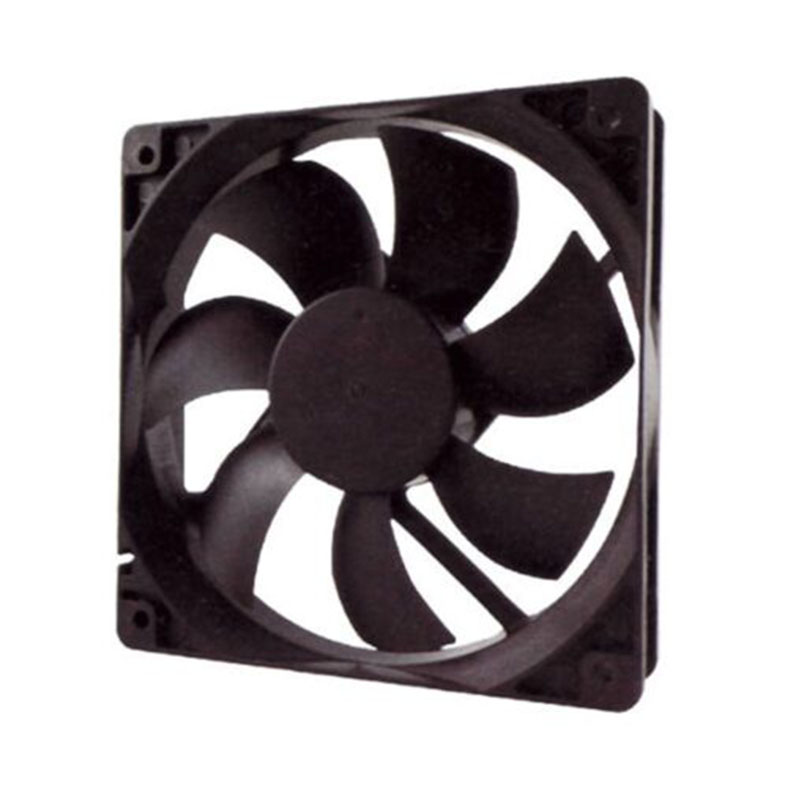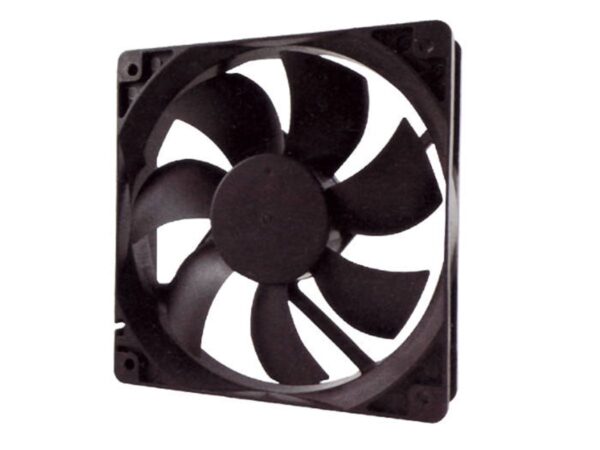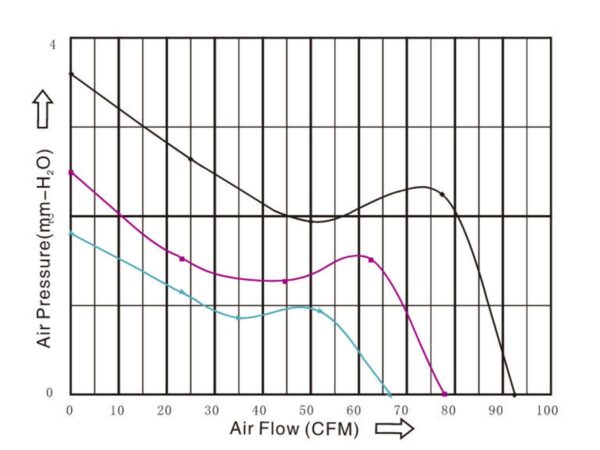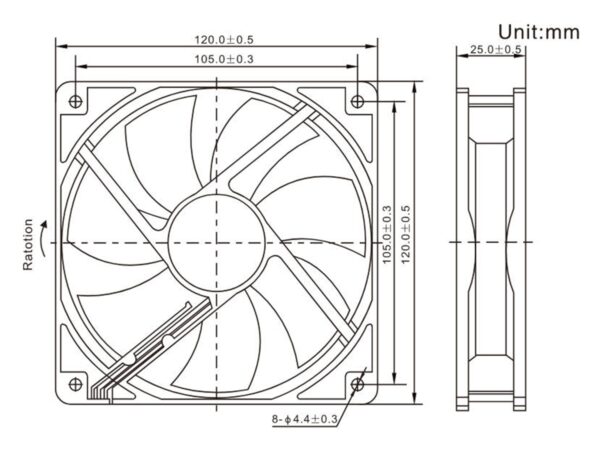


EC Axial Fan High Airflow Brushless 120mm x 25mm
Unveiling Exceptional Cooling Output: The 120mm High-Volume EC Axial Fan
Within the discipline of thermal management, where reliability and effectiveness are non-negotiable, this 120mm x 25mm EC (Electronically Commutated) axial fan emerges as a leading solution for a wide array of cooling and ventilation challenges.
Constructed with cutting-edge technology and a focus on vigorous performance, this unit is engineered to satisfy the rigorous demands of modern electronics, industrial equipment, and sophisticated airflow systems. Its conventional dimensions and excellent operational metrics establish it as a versatile and indispensable part for engineers, system designers, and technology aficionados.



The Core of the Unit: Progressive EC Motor Technology
Central to the design of this high-output fan is its Electronically Commutated (EC) motor. This is not a mere conventional fan motor; it embodies a significant technological advancement in both efficiency and control. EC technology skillfully integrates the advantages of AC and DC motors. While it draws power from a standard AC source, its internal circuitry converts this to DC, facilitating precise, brushless operation.
This brushless construction is a key distinguishing feature, as it does away with the mechanical friction and degradation linked to carbon brushes in traditional motors. The result is a trio of primary advantages: greatly improved energy efficiency, a much longer functional lifespan, and exceptionally quiet operation.
When compared to conventional AC motors, which can dissipate a large portion of energy as heat, EC motors are vastly more efficient, with some analyses indicating they use as much as 50% lower power consumption. This efficiency not only leads to reduced operating expenses and a smaller environmental impact but also means the fan itself produces less waste heat. This contributes to a cooler, more stable environment for any surrounding components.
Designed for Adaptability: The 120mm Benchmark
The fan's physical dimensions, 120mm by 120mm with a 25mm depth, represent a common industry benchmark. This universality guarantees effortless incorporation into a multitude of new and existing designs. The engineering diagram verifies these exact measurements, showing a housing of 120.0 ± 0.5 mm and mounting holes with a spacing of 105.0 ± 0.3 mm apart. This ensures compatibility and simplified installation in computer chassis, server racks, networking cabinets, and a broad spectrum of electronic enclosures. The standardized sizing makes it a perfect selection for both original equipment manufacturer (OEM) uses and for upgrading current systems to boost their cooling performance.
Interpreting Performance: Airflow and Static Pressure
A fan's true effectiveness is revealed in its performance chart, which depicts the interplay between air movement and static pressure.
Airflow (CFM): The horizontal axis on the provided graph illustrates airflow, which is measured in Cubic Feet per Minute (CFM). This number quantifies the sheer volume of air the fan is capable of moving without obstruction. The graph indicates this model can reach a peak airflow of approximately 90-95 CFM under "free delivery" situations, where there is zero resistance. This high volume is vital for uses that demand rapid heat removal and significant air exchange.
Static Pressure (mm-H₂O): The vertical axis represents static pressure, recorded in millimeters of water (mm-H₂O). Static pressure is the force a fan can exert to push air through opposition. This opposition, known as system impedance, is caused by obstacles like fine-finned heatsinks, filters, protective grilles, and restrictive ducting. A fan with high static pressure is crucial for adequately cooling components that are packed tightly together or for pushing air through long and complex pathways. The chart indicates this fan can produce a maximum static pressure that exceeds 3.5 mm-H₂O at almost no airflow (the "shut-off" condition).
The performance curves on the graph display this reciprocal connection: as the opposition (static pressure) within a system grows, the resulting airflow diminishes. The different curves (black, purple, cyan) on the chart typically show the fan's output at various discrete speeds or under different control settings (like PWM signals), which allows for a spectrum of operational points. This highlights the fan's variable speed function, a key attribute of EC technology that enables users to find a balance between cooling output, acoustic levels, and power usage.
An engineer can superimpose their system's unique resistance curve onto this graph; the point where the system curve intersects a fan performance curve indicates the precise operating condition (the actual CFM and pressure) that will be realized.
A Broad Spectrum of Uses
The combination of high airflow, considerable static pressure, advanced motor engineering, and a standard form factor makes this 120mm EC axial fan extremely adaptable. Its uses span numerous industries and scenarios:
Performance Computing and IT: In servers, high-end workstations, and gaming computers, where powerful CPUs and graphics cards generate immense heat, this fan can be used to exhaust warm air from the chassis or direct cool air across vital parts, promoting system stability and longevity.
Networking and Telecommunications: Routers, switches, and other networking hardware located in densely packed racks depend on reliable airflow to avert overheating and maintain uninterrupted service.
Industrial Controls and Automation: In factory environments, control panels and enclosures for machinery are frequently sealed to protect delicate electronics from dust and moisture. This fan can supply the required internal air circulation to remove heat and sustain ideal operating temperatures for PLCs, drives, and power components.
General Airflow and Ventilation: Beyond cooling electronics, this fan is well-suited for a variety of ventilation duties, such as improving air circulation in small enclosures, boosting airflow within HVAC ductwork, or serving as part of a custom air filtering or purification system.
Consumer Appliances and Electronics: From sophisticated audio-visual receivers requiring quiet operation to appliances needing dependable cooling, the efficiency and low acoustic profile of this fan make it a very attractive option.
In summary, this 120mm x 25mm brushless EC axial fan is a testament to modern thermal design. It presents a potent, efficient, and dependable cooling solution adaptable to a myriad of uses. By harnessing the superior qualities of its electronically commutated motor and its well-balanced aerodynamic construction, it provides the high airflow and static pressure necessary to safeguard valuable electronic parts and sustain peak performance in even the most challenging settings.

